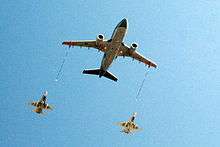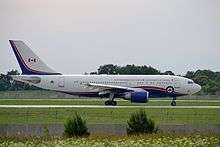Airbus CC-150 Polaris
| CC-150 Polaris | |
|---|---|
 | |
| A Royal Canadian Air Force Polaris taking off from Ottawa Airport | |
| Role | Strategic transport/VIP transport/tanker |
| Manufacturer | Airbus |
| Introduction | 1992 |
| Status | Active service |
| Primary users | Canadian Forces Royal Canadian Air Force |
| Number built | 5 (all converted from Airbus A310-300) |
| Developed from | Airbus A310 MRTT |
The Airbus CC-150 Polaris is the designation for the civilian Airbus A310-300s which have been converted for use as the primary long distance transport aircraft and mid-air refueler for the Royal Canadian Air Force.
Design and development
The fleet of five Airbus aircraft were originally purchased by Wardair as civilian airliners. The five were delivered between 1987-1988 and transferred to Canadian Airlines when the two airlines merged in 1989. They were subsequently purchased by the Canadian Forces from Canadian Airlines and converted for military use with the aircraft entering service between December 1992 and August 1993.[1][2] Four of the five aircraft were converted to the Combi-Freighter standard with a reinforced floor and side opening cargo door. The fifth was modified as a VIP transport aircraft for government executive transport.
The CC-150 replaced the Boeing CC-137 (converted Boeing 707) as a strategic transport upon the retirement of the final transport-configured CC-137s in 1995.
Tanker Conversion

In 2008, two of the five CC-150s were converted to air-to-air refueling tankers for the CF-18 fleet as part of the Multi Role Tanker Transport (MRTT) program. The MRTT program was initiated because of a German Air Force requirement and provided a cost effective solution for the Canadian Forces. The converted aircraft have been designated as the CC-150T. The tanker has hose-drogue pods under the wings.
The RCAF uses converted C-130s, RCAF designation CC-130H(T), for tactical air-to-air refueling but is limited when deploying CF-18s overseas which is better suited by a Strategic AAR Platform. As a result of the CC-150's MRTT conversion, Canada regained its own strategic air-to-air refuelling capability, which had been lost when the final tanker-configured CC-137s were retired in 1997.
The first converted CC-150T completed its acceptance trials in May 2008.[3]
Operational history
The Polaris is classified as a strategic airlifter by the Royal Canadian Air Force. The CC-150 is able to carry cargo and personnel over long distances, but it lacks the oversize cargo capacity and ability to operate from austere locations which are a common requirement of military airlift. The Canadian Forces rely on other heavy lift cargo aircraft (such as the C-17 Globemaster) for these kinds of operations.
The five CC-150s are operated by 437 Squadron at CFB Trenton, Ontario.
In 2011, two CC-150T air-to-air refueling tankers were deployed to support Canadian CF-18 fighter jets enforcing the no-fly zone over Libya under Operation Mobile and Operation Unified Protector.[4]
The initial purchase from Canadian Airlines in 1992 included a support contract for service of the aircraft for a fixed number of flying hours. Air Canada acquired the CC-150 service contract when it purchased Canadian Airlines in 2000, and through a series of subsequent corporate restructurings, spawned the CC-150 service contract to Air Canada Technical Services (ACTS), and then Aveos Fleet Performance. Following the collapse of Aveos Fleet Performance in March, 2012, the Government of Canada awarded a one-year interim contract to L3 Communications to support the fleet of CC-150 aircraft until Canada can award a longer term aircraft maintenance contract through a competitive procurement process.[5]
Use as VIP transport
The decision to outfit one of the five CC-150s as a VIP transport intended for use by the Prime Minister of Canada, made while Brian Mulroney held office, was politically controversial. The $56 million in upgrades were criticized as a needless extravagance during a time of government budgetary challenges by then-Leader of the Opposition Jean Chrétien, who labelled the aircraft a "flying Taj Mahal". Chrétien became Prime Minister soon thereafter and tried and failed to sell the aircraft; he would refuse to make use of the CC-150 during his ensuing 11 years in office. The aircraft was parked at Canadian Forces Base Uplands on standby, two aircraft were used in its place primarily the CC-144 Challenger.[6]and a second CC-150 when a larger aircraft was required.
Subsequent refits to and from use as a troop transport would result in much of the VIP amenities being downgraded. The CC-150 would return to use as official transport for the prime minister under Paul Martin in 2004.[6]

In 2011 it emerged that since early 2009 the office of Prime Minister Stephen Harper had repeatedly requested that the CC-150 configured for VIP use be repainted from the gun-metal military paint scheme it shared with the other CC-150s to a specialized paint scheme. The Department of National Defence, including Minister Peter MacKay, had resisted this request, noting that it was contrary to its multi-role nature and would compromise the aircraft's potential to safely transport personnel into a combat zone. The decision was ultimately made to repaint the craft during its next scheduled heavy maintenance.[7]
In 2013, the VIP-configured CC-150, aircraft #01, was repainted during scheduled heavy maintenance at a cost of $50,000. The new scheme, predominantly white with significant quantities of blue and smaller amounts of red, was criticized heavily by opposition politicians, who alleged the repainting was intended to give prominence to the then-governing Conservative Party of Canada's traditional blue colour.[8] Its call sign is known officially as CAN Force One.[9]
Variants
- CC-150
- 1 VIP transport
- 2 strategic airlifters
- CC-150T
- 2 aerial refueling tankers/strategic airlifters
Operators
Specifications
General characteristics
- Crew: 2 (flightcrew)
- Capacity: 194 passengers
- Length: 46.66 m (153 ft 1 in)
- Wingspan: 43.9 m (144 ft 0 in)
- Height: 15.8 m (51 ft 10 in)
- Gross weight: 157,000 kg (346,126 lb)
- Powerplant: 2 × General Electric CF6-80C2A2 high bypass turbofan engines, 220 kN (50,000 lbf) thrust each
Performance
- Maximum speed: Mach 0.84
- Range: 9,600 km (5,965 mi; 5,184 nmi)
- Service ceiling: 12,500 m (41,000 ft)
See also
Related development
Aircraft of comparable role, configuration and era
Related lists
References
- ↑ "PlaneSpotters.net - Canadian Armed Forces 15003". Archived from the original on 2016-03-04. Retrieved 2016-01-03.
- ↑ "PlaneSpotters.net - Canadian Armed Forces 15003". Archived from the original on 2016-03-04. Retrieved 2016-01-03.
- ↑ Strategic air-to-air refuelling capability Archived 2012-12-29 at WebCite
- ↑ "Update on CF Operations in Libya" Canadian Forces website, 22 March 2011
- ↑
- 1 2 Martin's first foreign tour begins on a sad note
- ↑ PM, MacKay in 2-year tussle over Airbus paint
- ↑ Stephen Harper’s jet makeover slammed by opposition
- ↑ http://nationalpost.com/news/politics/canada-looking-at-replacing-fleet-of-vip-aircraft-as-it-passes-31st-birthday
External links
| Wikimedia Commons has media related to Airbus CC-150 Polaris. |